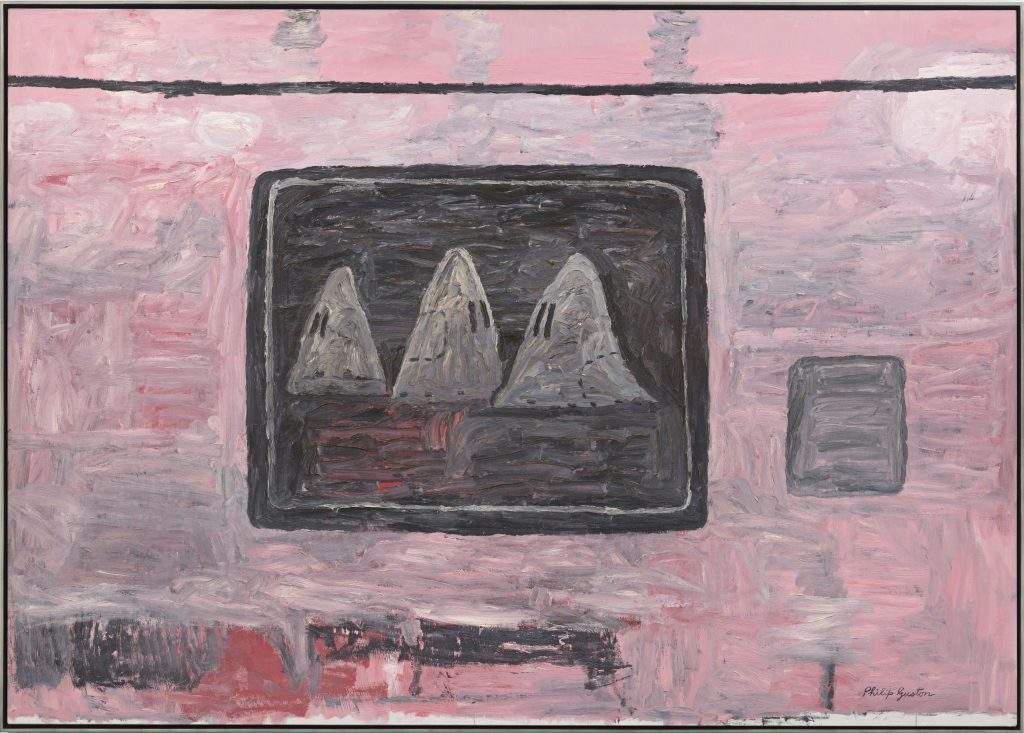On display at Hauser & Wirth, from September 9 to October 30, 2021, will be the works of Philip Guston (Montréal, 1913 - Woodstock, 1980) that stirred fierce controversy last year, when a major retrospective exhibition on the American painter (among the leading exponents ofAbstract Expressionism) that was scheduled to be held at the National Gallery in Washington and then on three successive stages (at the Museum of Fine Arts, Houston, Tate Modern, London, and the Museum of Fine Arts, Boston) was postponed until 2024 because of criticism that arose around some of Guston’s paintings from the Klan Paintings series. The series, from 1969, depicts a number of people covered in the white hoods of the Ku Klux Klan as they engage in a variety of everyday activities. A denunciation in the artist’s intentions, but evidently many feel these paintings are liable to be interpreted in a negative sense if the National Gallery has had to run for cover by stating that the wrong reception of the paintings could be detrimental to a proper reading of the works.
The fact remains that despite opposition from the cultural world (artists, critics and intellectuals wrote letters to the museum asking it not to suspend the exhibition), the National Gallery opted to stop. And now these works are going on display at the New York branch of Hauser & Wirth, one of the world’s leading galleries, which evidently decides not to care about the criticism: the Philip Guston: 1969-1979 exhibition is already scheduled and, barring any sensational and unlikely turn of events, will take place. Officially, there is no connection with the controversy that has accompanied the retrospective scheduled in the four museums: Hauser & Wirth simply intends to offer the public and collectors an exhibition that will focus on a fundamental decade in the artist’s production.
In fact, the exhibition will display paintings (some of which have never been shown before) that record Guston’s transition from abstractionism to a new figuration, which made use of dark, cartoony images (such as those in the Klan Paintings) to narrate American reality. They are works that mark an important moment in modern American art partly because, the gallery explains, they show courage in confronting the injustices of American society that Guston had witnessed since he was a boy. “The paintings,” reads a note, “were executed by Guston at the height of his artistic career, and attest to his enduring influence and extraordinary relevance to artists and audiences today.”
Philip Guston, 1969 - 1979 thus seeks to shed light on the final part of Guston’s career, a period during which the painter tackled universal themes: the journey begins with works from 1969 that address the themes of the Tower of Babel and the City to speak of everyone’s complicity in perpetrating racism and intolerance. Uncomfortable works, characterized by a strong visual language that brings to mind tragedies such as the Holocaust, genocides, and racial murders, to provoke a feeling of unease in the viewer of the paintings. But some elements (for example, the light bulbs that offer the possibility of illumination) provide a foothold for hope, redemption.
The exhibition is supported by a scientific committee of experts on Philip Guston’s art and also aims to open up new research on the artist’s career, in continuity with the results of the previous exhibition Philip Guston: Painter 1957 - 1967 held in 2016, which focused on the last ten years of abstractionism in the artist’s career. More information can be found on the Hauser & Wirth website.
Photo: Philip Guston, Blackboard (1969). ©The Estate of Philip Guston. Photo by Genevieve Hanson, courtesy the Estate and Hauser & Wirth.
 |
| Philip Guston's works that sparked a thousand controversies go on display at Hauser & Wirth |
Warning: the translation into English of the original Italian article was created using automatic tools. We undertake to review all articles, but we do not guarantee the total absence of inaccuracies in the translation due to the program. You can find the original by clicking on the ITA button. If you find any mistake,please contact us.